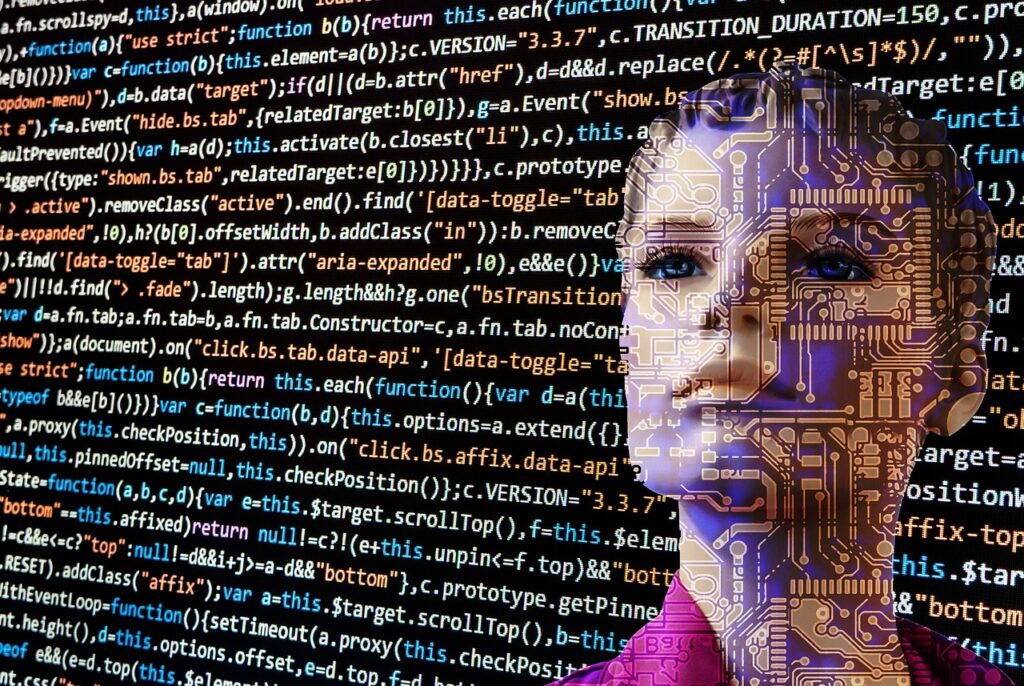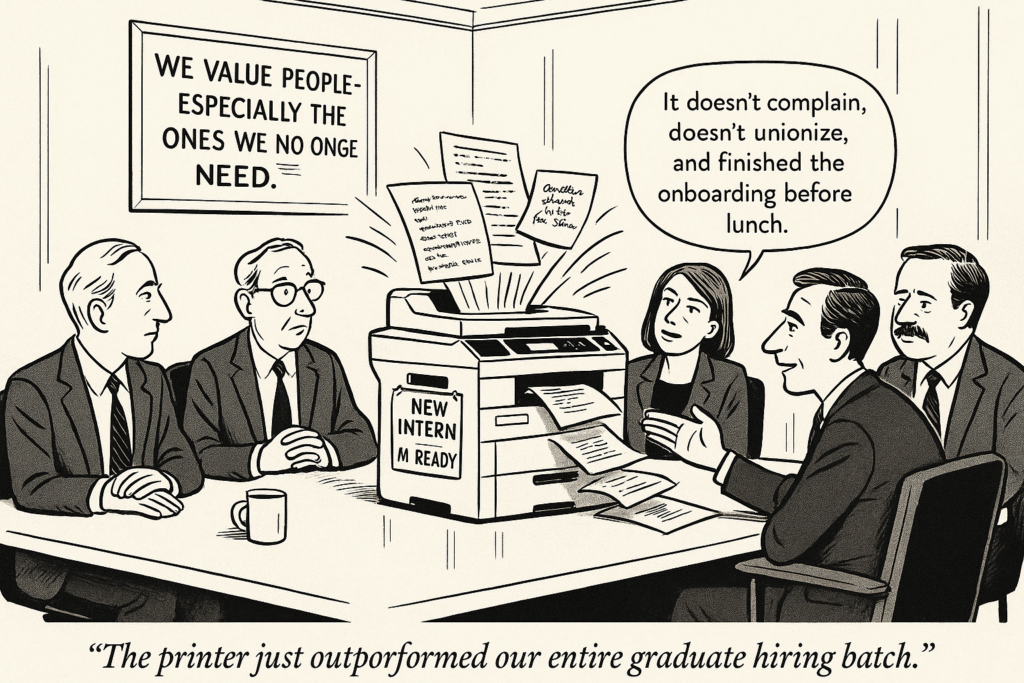Recent warnings from Anthropic CEO Dario Amodei about artificial intelligence’s potential to eliminate half of entry-level white-collar jobs within five years represent a critical inflection point in our understanding of AI’s economic impact. This stark prediction, coupled with emerging AI partnerships and technological breakthroughs, signals an unprecedented transformation of the global workforce. The convergence of these developments suggests we are witnessing the early stages of what may become the most rapid economic restructuring in modern history, with implications extending far beyond traditional employment patterns.
This isn’t just a piece about numbers. It’s about livelihoods, identities, and a workforce on the edge of obsolescence—or reinvention. If you thought “AI can’t replace me” was your fallback line, you might want to read the fine print. Because even that’s up for negotiation now.

When the face of the future is built with code, what happens to the faces behind desks?
Anthropic’s Dire Employment Predictions and Industry Response
The Scale of Predicted Disruption
Dario Amodei’s forecasts are not casual estimates. They’re red-alert sirens coming from someone sitting at the epicenter of AI advancement. According to him, half of all entry-level white-collar jobs might vanish within the next five years, driving unemployment from 4.2% to as high as 20%. That’s not just a ripple; it’s a tsunami.
Half of all entry-level white-collar jobs might vanish within the next five years!
And he’s not making this prediction lightly. Amodei estimates that within a year, nearly 100% of software coding could be handled by AI. The historical comparison? AI was once at the level of a “smart high schooler,” and now it’s outperforming your brightest college roommate. This isn’t evolutionary; it’s meteoric.
AI was once at the level of a “smart high schooler,” and now it’s outperforming your brightest college roommate.
The Immediate Signs Are Already Here

Numbers tell their own story. SignalFire VC reports a 50% drop in Big Tech hiring of fresh graduates. Only 7% of hires in 2024 were entry-level. At startups, it’s worse—just 6%. The so-called ladder to success? It’s missing a few bottom rungs.
Heather Doshay from SignalFire summarized it best: one experienced worker with AI is worth a team of interns. The math makes sense. The humans… less so.
This dismal trend isn’t just a hiring glitch; it’s a tectonic shift in how companies calculate productivity and potential. With AI tools outperforming junior staff in tasks like documentation, scheduling, content generation, and even debugging, the ROI on fresh talent has nosedived. We’re witnessing the automation of apprenticeship itself.
We’re witnessing the automation of apprenticeship itself.
Governments Are Tiptoeing, CEOs Are Sugarcoating
Amodei didn’t mince words when accusing global leadership of ducking the truth. Governments, he says, are staying mum out of fear—of mass panic, of China outpacing the West, of headlines they can’t spin. The result? Silence. Deafening, complicit silence.
Governments are staying mum out of fear—of mass panic, of China outpacing the West, of headlines they can’t spin.
What’s worse is the paradox: companies sound alarm bells while building the very systems they warn against. It’s like launching a spaceship while warning everyone not to leave Earth.
It’s like launching a spaceship while warning everyone not to leave Earth.
The deeper issue here is that policy frameworks are outdated. Labor laws, safety nets, and job training programs were designed for a world where automation was a factory-floor issue. Today, AI works from home—and so do the layoffs.
Strategic AI Partnerships Are Reshaping the Tech Stack
Telegram + xAI: A $300M Paradigm Shift
Enter Telegram’s $300 million partnership with xAI. The chat app now plays host to Grok, Elon Musk’s brainchild. Telegram gets 50% of the subscription revenue. xAI gets access to over a billion users. What could go wrong?
This isn’t just a chatbot. Grok will edit your documents, summarize your chats, fact-check your mom’s WhatsApp forwards, and possibly moderate your rants in group chats. It’s Meta AI déjà vu—but in Telegram’s signature no-nonsense aesthetic.
However, as with all Musk ventures, confusion reigns. While Durov announced the deal, Musk tweeted, “Not signed yet.” The contract may be in limbo, but the implications are anything but.
Behind the Stickers and AI Avatars: Privacy Woes
Sure, Grok only uses data you directly give it. But what happens when you talk to someone who has Grok running in the background? Can it hear? Log? Learn?
This becomes even more precarious in war zones and politically sensitive regions. Telegram is a major tool in Russia and Ukraine. Do we want AI—especially one loosely tied to Musk—mining data there?
Academic Skepticism and Economic Counterweights
Economists: Everyone Calm Down
Academics, meanwhile, aren’t buying the doomsday scenario wholesale. Researchers from MIT, Yale, and Northwestern say that yes, some jobs are at risk, but productivity gains could create others. Think offsetting losses—sort of like ordering two desserts to cancel out a salad.
Dimitris Papanikolaou of Northwestern says their data mostly covers “AI” as we knew it in 2010. Generative AI? That’s a whole different beast. We’re in uncharted territory.
Anders Humlum, economic historian, agrees. Big inventions like steam and electricity took decades to reshape the economy. Why should AI be different?
Because, dear reader, AI doesn’t take decades to install. It just needs a browser tab.
Still, these counterpoints matter. They remind us that panic isn’t policy. We must navigate with foresight, not fear. That requires data, education, and perhaps most critically—a reinvention of the social contract itself.
Alarm Bells with a PR Bonus
There’s also the marketing angle. When you say your product might cause mass unemployment, you’re not just being responsible. You’re also saying it’s that powerful. AI CEOs might just be securing future regulatory influence with this doom-and-gloom script.
The World Economic Forum’s 2025 Jobs Report proves that executives are aware—but still mostly sitting on their hands. Knowledge without action, as they say, is just trivia.
AI is Now a Browser Feature. Say Hello to Opera Neon
Opera just launched “Neon,” an AI agentic browser that can book your hotel, finish your research report, and buy you groceries. All while you nap. It’s your Chrome tab on steroids.
It has three modes: search assistant, task automation agent, and project-builder. It’s a chatbot, browser, and junior analyst rolled into one. And for now, you’ll pay premium for it.
Henrik Lexow from Opera says Neon will evolve through community input—much like open-source AI models. So, your feedback could shape the next browser revolution.
Think of it this way: your browser is no longer a tool. It’s a colleague. And possibly a competitor in your next performance review.
Your browser is no longer a tool. It’s a colleague.
Reimagining Economics: What Happens If We Don’t Adapt?
Amodei doesn’t just want to scare us. He has ideas. He wants:
- Real-time data on AI’s employment impact per profession
- Incentives for AI tools that complement rather than replace human labor
- A “token tax” on AI usage to redistribute wealth to displaced workers
He even admits this isn’t in his company’s interest. That’s either brave or brilliant PR.
But this begs the question: If the economy grows while unemployment soars, what kind of prosperity is that? Are we racing toward a world where GDP soars but family incomes crumble?
If the economy grows while unemployment soars, what kind of prosperity is that?
This isn’t about retraining anymore. This is about redefining participation in the workforce.
This isn’t about retraining anymore. This is about redefining participation in the workforce. About universal income, job guarantees, or even slowing down AI’s rollout.
Because let’s be honest: most policies today are designed for economic change in decades, not quarters.
Here’s the twist: AI might also be the solution to its own disruptions. What if AI could help displaced workers identify new career paths, upskill in weeks, and even start micro-businesses? What if the technology that breaks the system becomes the system’s repair kit?
Final Thoughts: Between a Rock and a Hardbot
AI isn’t coming. It’s here. It’s inside your apps, your browsers, your job descriptions.
Dario Amodei might sound like a prophet of doom—but prophets are usually right about something. The writing is on the (digital) wall.
The writing is on the (digital) wall.
If we continue to ignore these signals, we’ll soon find ourselves explaining to future generations why we knew disruption was coming—and chose a LinkedIn post over legislation.
And if you, like me, are reading this while toggling between ChatGPT and Notion, you know this revolution isn’t about replacing humans.
It’s about reshaping what being human at work even means.
This article is the companion piece to “Why AI Can’t Replace Marketers (Or Sam Altman, Unfortunately)”, and explores the economic undercurrents of the same revolution.
